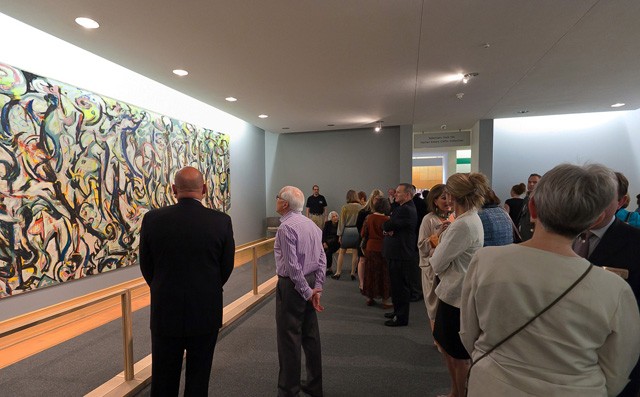
|
||
|
Portland art blog + news + exhibition reviews + galleries + contemporary northwest art
|
||
Guggenheim Mural Restoration )
Pollock's famous Guggenheim Mural has undergone a restoration and the Getty has released a fascinating video regarding the work. I saw the work on display at the Des Moines Art Center and discussed it a little with their Director here. I'm uncertain how I feel about the shaped canvas solution the Getty chose but it surely does address the odd issue of revealed unpainted areas due to distortion that were very notable when I saw it. It gave the painting an odd "artifact" of history aspect that bothered me. Generally, I prefer a painting be a present presence where I'm less aware of restorations. This is doubly true because it is a mural and I agree in principle with Christopher Knight who wrote yesterday on his feeling that it is installed wrong now. At the Des Moines Art Center it was displayed in a room with lower ceilings and the compression emphasizes field of view horizontal aspects to much greater effect than the Getty's hang now does. Still, the problem with the Getty's hang isn't the distance from the floor as much as the immense height of the gallery. As Knight pointed out it undermines its best qualities as a space shaping/filling mural.  Jackson Pollock's Guggenheim Mural on display at Des Moines Art Center (2012) It is fascinating and very important that the painting is now proven to be a multi-layered and multi-stepped undertaking, not a project completed in a single furious exegesis of paint applied in one session. That makes sense and it furthers Pollock's reputation as an intentional innovator... not someone who simply got lucky when under the gun like the University of Iowa's site (and much of current art history) currently tells it. History is almost always mmore complicated than initially reported. My guess is that Guggenheim, Greenberg, Krasner and Pollock all felt the card of Yankee ingenuity needed to be played up... a creation myth where Pollock created American abstract painting in one intense session. The fact is he tactically developed a compelling sketch on the canvas and executed it over a period of time. Other great, art shifting paintings like Les Demoiselles d'Avignon had a similar approach but perhaps they wanted to portray Pollock as more intuitive like Van Gogh? There is a reason for this. Remember that WWII was still raging as this piece was being worked on. The world was filled with large scale tactical repositioning of forces and resources... it was a time when the world had become a machine of war chewing through lives and countries, grinding everything to rubble as it passed. It was a time when people distrusted the rational... that was a general's game and Pollock being portrayed as an innocent innovator in a single session of improvisation was a grand respite in a world already crowded with grand plans and empires. Posted by Jeff Jahn on March 11, 2014 at 9:56 | Comments (0) Comments Post a comment Thanks for signing in, . Now you can comment. (sign out)
(If you haven't left a comment here before, you may need to be approved by
the site owner before your comment will appear. Until then, it won't appear
on the entry. Thanks for waiting.)
|
| s p o n s o r s |
 |
 |
 |
 |
 |
 |
 |
 |
 |
 |
 |
 |
 |
 |
 |
 |

|
Site Design: Jennifer Armbrust | • | Site Development: Philippe Blanc & Katherine Bovee | |

